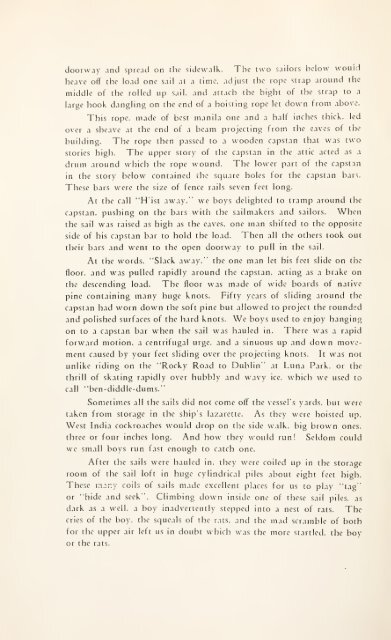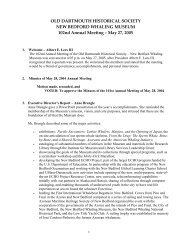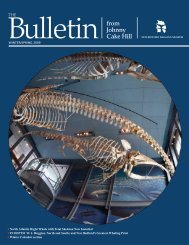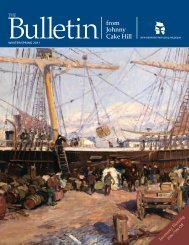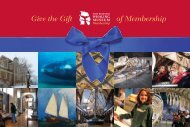Old Dartmouth historical sketches - New Bedford Whaling Museum
Old Dartmouth historical sketches - New Bedford Whaling Museum
Old Dartmouth historical sketches - New Bedford Whaling Museum
Create successful ePaper yourself
Turn your PDF publications into a flip-book with our unique Google optimized e-Paper software.
doorway and spread on the sidewalk. The two sailors below would<br />
heave ofl the load one sail at a time, adjust the rope strap around the<br />
middle of the rolled up sail, and attach the bight of the strap to a<br />
large hook dangling on the end of a hoisting rope let down froin above.<br />
This rope, made of best manila one and a half inches thick, led<br />
over a sheave at the end of a beam projecting from the caves of the<br />
building. The rope then passed to a wooden capstan that was two<br />
stories high. The upper story of the capstan in the attic acted as a<br />
drum around which the rope wound. The lower part of the capstan<br />
in the story below contained the square holes for the capstan bars.<br />
These bars were the size of fence rails seven feet long.<br />
At the call "H'ist away." we boys delighted to tramp around the<br />
capstan, pushing on the bars with the sailmakers and sailors. When<br />
the sail was raised as high as the eaves, one man shifted to the opposite<br />
side of his capstan bar to hold the load. Then all the others took out<br />
their bars and went to the open doorway to pull in the sail.<br />
At the words, "Slack away." the one man let his feet slide on the<br />
floor, and was pulled rapidly around the capstan, acting as a brake on<br />
the descending load. The floor was made of wide boards of native<br />
pine containing many huge knots. Fifty years of sliding around the<br />
capstan had worn down the soft pine but allowed to project the rounded<br />
and polished surfaces of the hard knots. We boys used to enjoy hanging<br />
on to a capstan bar when the sail was hauled in. There was a rapid<br />
forward motion, a centrifugal urge, and a sinuous up and down movement<br />
caused by your feet sliding over the projecting knots. It was not<br />
unlike riding on the "Rocky Road to Dublin" at Luna Park, or the<br />
thrill of skating rapidly over bubbly and wavy ice, which we used to<br />
call<br />
"ben-diddle-dums."<br />
Sometimes all the sails did not come off the vessel's yards, but were<br />
taken from storage in the ship's lazarcttc. As they were hoisted up.<br />
West India cockroaches would drop on the side walk, big brown ones,<br />
three or four inches long. And how they would run! Seldom could<br />
we small boys run fast enough to catch one.<br />
After the sails were hauled in, they were coiled up in the storage<br />
room of the sail loft in huge cylindrical piles about eight feet high.<br />
These many coih of sails made excellent places for us to play "tag"<br />
or "hide and seek". Climbing down insiJc one of these sail piles, as<br />
dark as a well, a boy inadvertently stepped into a nest of rats. The<br />
cries of the boy. the squeals of the rats, and the mad scramble of both<br />
for the upper air left us in doubt which was the more startled, the boy<br />
or the rats.


